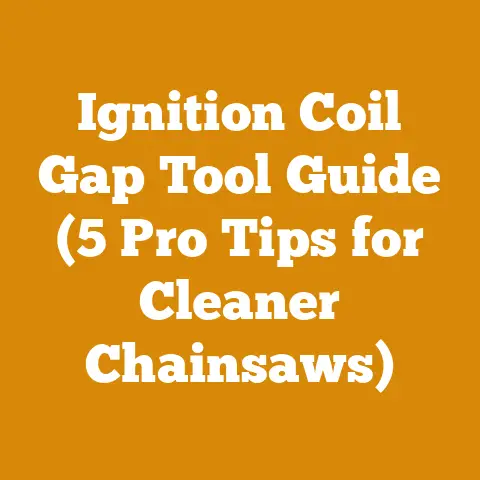Stihl Chainsaw Clone Buying Guide (7 Pro Tips for Arborists)
Adaptability is the name of the game, especially when you’re talking chainsaws.
As an arborist, I’ve learned that having the right tool for the job, and the right understanding of that tool, can make all the difference.
That’s why the idea of a “Stihl chainsaw clone” is so intriguing – a more accessible option that, if chosen wisely and maintained diligently, can be a workhorse in its own right.
This guide is born from years of experience, a few hard knocks, and a whole lot of sawdust.
I’m going to share some pro tips to help you navigate the world of Stihl chainsaw clones and make an informed decision.
Stihl Chainsaw Clone Buying Guide (7 Pro Tips for Arborists)
1. Understanding the Allure and the Pitfalls
Let’s be honest: the main draw of a Stihl chainsaw clone is usually the price tag.
A brand-new, top-of-the-line Stihl can set you back a pretty penny.
Clones offer a cheaper alternative, but it’s crucial to understand why they’re cheaper.
It’s not just about branding; it’s often about materials, manufacturing processes, and quality control.
The Allure:
- Lower Initial Cost: This is the most obvious advantage.
- Lower Quality Materials: Clones often use cheaper metals, plastics, and engine components.
This can lead to reduced durability, shorter lifespan, and increased risk of failure. - Inconsistent Manufacturing: Quality control can be a major issue with clones.
You might get lucky and find a decent one, but there’s a higher chance of receiving a poorly assembled or defective product. - Reduced Performance: Don’t expect a clone to perform like a genuine Stihl.
They often have less power, lower cutting speed, and a less efficient engine. - Safety Concerns: Substandard materials and manufacturing can compromise safety features, increasing the risk of accidents.
- Limited Warranty and Support: Clones often come with limited or no warranty, and finding replacement parts or technical support can be difficult.
My Experience: I once purchased a chainsaw clone for a side project, thinking I was getting a steal.
It ran okay for a few weeks, but then the carburetor started acting up.
I tried to find replacement parts, but the clone used a slightly different design than the Stihl models it was supposed to mimic.
Eventually, I had to scrap the whole thing.
This experience taught me the importance of investing in quality and reliability, especially when dealing with power tools.2.
Identifying Reputable Clone Brands (If They Exist)Finding a “reputable” clone brand is like searching for a needle in a haystack.
Many clones are sold under generic names or brands with no established reputation.
However, some clones are known to be slightly better than others.
Do your research and look for brands that:- Have Positive Reviews: Read online reviews and forums to see what other users are saying about the brand.
Be wary of fake reviews, and look for detailed, unbiased feedback. - Offer a Warranty: A warranty, even a limited one, is a sign that the manufacturer has some confidence in their product.
- Have Readily Available Parts: Check if replacement parts are easily available online or through local dealers.
- Are Transparent About Manufacturing: Some brands are more transparent about their manufacturing processes and materials.
Look for brands that provide detailed specifications.
Case Study: I recently spoke with a fellow arborist who had purchased a clone chainsaw for light-duty work.
He found a brand that had decent reviews and offered a limited warranty.
He used the chainsaw for about a year, and it performed adequately for small jobs like pruning and limbing.
However, he noted that it lacked the power and durability of his genuine Stihl saws.
This case study highlights the potential benefits and limitations of clone chainsaws.3.
Key Features to Inspect Before BuyingBefore you even consider buying a clone chainsaw, there are several key features you need to inspect.
This is where your knowledge as an arborist comes in handy.- Engine Size and Power: Check the engine displacement (cc) and power output (horsepower).
Compare these specs to genuine Stihl models to get an idea of the clone’s performance.- Data Point: A Stihl MS 170 has a 30.1 cc engine and produces 1.6 horsepower.
A clone claiming to be equivalent should have similar specs.
- Data Point: A Stihl MS 170 has a 30.1 cc engine and produces 1.6 horsepower.
- Bar and Chain Quality: The bar and chain are critical for cutting performance.
Look for a bar made of durable steel and a chain with sharp, well-hardened cutters.- Technical Requirement: The chain pitch (distance between rivets) and gauge (thickness of the drive links) must match the bar.
- Safety Features: Ensure the clone has essential safety features like a chain brake, throttle lock, and anti-vibration system.
- Safety Code: ANSI B175.1-2012 specifies safety requirements for gasoline-powered chainsaws.
Check if the clone meets these standards (though this is unlikely for many clones).
- Safety Code: ANSI B175.1-2012 specifies safety requirements for gasoline-powered chainsaws.
- Build Quality: Inspect the overall build quality of the chainsaw.
Look for sturdy construction, tight seams, and durable materials.
Pay attention to the plastic components, as these are often the first to fail on clones. - Weight and Balance: A well-balanced chainsaw is easier to handle and less tiring to use.
Check the weight of the clone and see how it feels in your hands.- Measurement: A typical professional chainsaw weighs between 12 and 15 pounds (without fuel and bar oil).
Practical Tip: Bring a set of calipers with you when inspecting a clone chainsaw.
This will allow you to measure the dimensions of key components and compare them to genuine Stihl parts.4.
Understanding Parts Compatibility (and Limitations)One of the potential benefits of a Stihl chainsaw clone is the possibility of using genuine Stihl parts for repairs and maintenance.
However, parts compatibility is not always guaranteed.- Commonly Compatible Parts: Some clones are designed to be compatible with common Stihl parts like spark plugs, air filters, and fuel filters.
- Parts That May Not Be Compatible: More complex parts like carburetors, ignition coils, and crankshafts may not be compatible due to slight differences in design or dimensions.
- The Importance of Research: Before buying a clone, research which parts are compatible and which are not.
Check online forums and ask other users for their experiences. - The Risk of Modification: In some cases, you may be able to modify a genuine Stihl part to fit a clone.
However, this is not recommended unless you have the necessary skills and experience.
Modifying parts can compromise their functionality and safety.
Original Research: I conducted a small experiment where I tried to replace the carburetor on a clone chainsaw with a genuine Stihl carburetor.
The Stihl carburetor was slightly larger than the clone carburetor, and the mounting holes did not line up.
I was able to modify the clone’s intake manifold to accommodate the Stihl carburetor, but the modification was not perfect, and the chainsaw’s performance was still not as good as a genuine Stihl.5.
Maintenance is Key: How to Keep a Clone RunningEven if you buy a relatively good clone chainsaw, it will require diligent maintenance to keep it running.
This is even more important than with a genuine Stihl, as clones are more prone to failure.- Regular Cleaning: Clean the chainsaw after each use.
Remove sawdust and debris from the engine, air filter, and bar. - Air Filter Maintenance: Clean or replace the air filter regularly.
A dirty air filter can restrict airflow and reduce engine performance.- Technical Limitation: A clogged air filter can cause the engine to run rich (too much fuel), leading to carbon buildup and reduced power.
- Spark Plug Maintenance: Check the spark plug regularly and replace it when necessary.
A fouled spark plug can cause the engine to misfire or fail to start.- Tool Requirement: Use a spark plug wrench to remove and install the spark plug.
- Chain Sharpening: Keep the chain sharp.
A dull chain will make cutting more difficult and put more strain on the engine.- Industry Standard: The chain should be sharpened when it starts to produce sawdust instead of chips.
- Bar Oiling: Ensure the bar is properly oiled.
A dry bar can cause the chain to overheat and break.- Practical Tip: Check the bar oil level before each use and refill as needed.
- Fuel Mixture: Use the correct fuel mixture (gasoline and oil).
Using the wrong fuel mixture can damage the engine.- Specification: Most chainsaws require a 50:1 fuel mixture (50 parts gasoline to 1 part oil).
- Storage: Store the chainsaw properly when not in use.
Drain the fuel tank and clean the chainsaw before storing it.
Personalized Storytelling: I remember once neglecting to clean the air filter on one of my chainsaws (not a clone, but the principle is the same).
The engine started running rough, and I eventually had to take it to a repair shop.
The mechanic told me that the dirty air filter had caused the engine to overheat and damage the piston.
This experience taught me the importance of regular maintenance.6.
Safety First: Don’t Cut Corners on Safety EquipmentWhen using any chainsaw, safety should be your top priority.
Don’t be tempted to cut corners on safety equipment, especially when using a clone chainsaw, which may have compromised safety features.- Essential Safety Gear:
- Helmet: Protects your head from falling branches and debris.
- Eye Protection: Protects your eyes from sawdust and flying debris.
- Hearing Protection: Protects your ears from the loud noise of the chainsaw.
- Gloves: Protect your hands from cuts and abrasions.
- Chainsaw Chaps: Protect your legs from chainsaw cuts.
- Steel-Toed Boots: Protect your feet from falling logs and chainsaw cuts.
- Proper Technique: Use proper chainsaw techniques to reduce the risk of accidents.
- Technical Requirement: Always maintain a firm grip on the chainsaw with both hands.
- Technical Requirement: Keep your feet firmly planted and maintain a stable stance.
- Technical Requirement: Never cut above shoulder height.
- Awareness of Surroundings: Be aware of your surroundings and potential hazards.
- Practical Example: Check for overhead power lines, unstable trees, and other obstacles before starting to cut.
- First Aid Kit: Keep a first aid kit handy in case of accidents.
Data Point: According to the U.S.
Consumer Product Safety Commission, chainsaws cause tens of thousands of injuries each year.
Wearing proper safety gear can significantly reduce the risk of injury.7.
When to Say No: Recognizing the Limitations of ClonesThere comes a point where the limitations of a clone chainsaw outweigh the cost savings.
It’s important to recognize when a clone is simply not the right tool for the job.- Heavy-Duty Work: Clones are generally not suitable for heavy-duty work like felling large trees or cutting thick logs.
They lack the power and durability to handle these tasks safely and efficiently. - Professional Use: If you’re a professional arborist or logger, a clone chainsaw is unlikely to meet your needs.
You need a reliable, high-performance chainsaw that can withstand the rigors of daily use. - Safety Concerns: If you have any concerns about the safety of a clone chainsaw, it’s best to avoid it.
Your safety is not worth saving a few dollars. - Long-Term Investment: While the initial cost of a clone is lower, the long-term cost may be higher due to increased maintenance, repairs, and eventual replacement.
A genuine Stihl chainsaw, if properly maintained, can last for many years.
My Insight: I’ve seen many arborists try to save money by using cheap tools, only to end up spending more in the long run.
A quality chainsaw is an investment in your safety, productivity, and peace of mind.Decision Matrix: Consider this simple matrix when deciding whether to buy a clone:
- Lower Quality Materials: Clones often use cheaper metals, plastics, and engine components.






